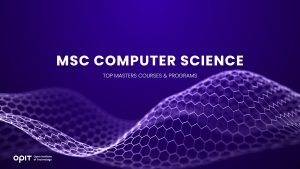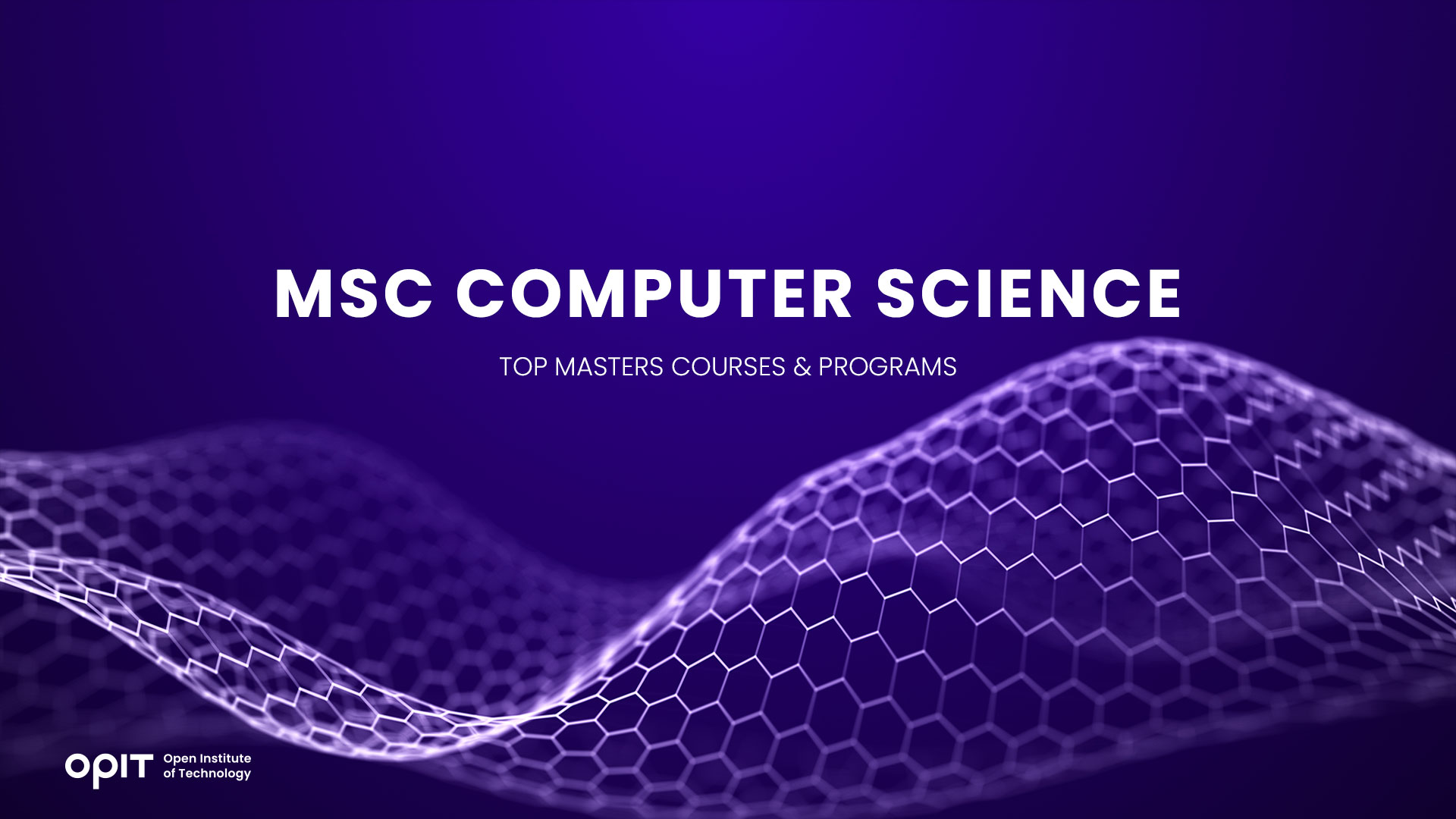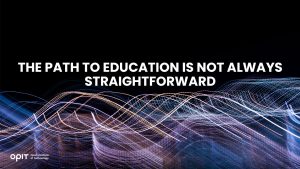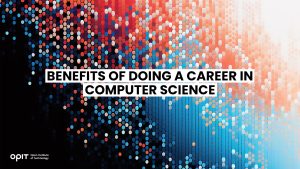

Finding an industry or even area of life that doesn’t utilize digital technologies is quite a challenge today. As computers continue to impact the ways we do business and live, understanding their capabilities and limitations becomes essential. This is the gist of what computer science is all about.
The tasks of computer science keep growing in scope and complexity. This means the demand for professionals in the field is always on the rise. Global companies are always on the lookout not only for people who know computer science but are also experts in the field.
For these reasons, getting an MSc in Computer Science can be the best career move in the modern landscape. Masters in Computer Science allows you to gain detailed knowledge and choose a specialized path. Better yet, holding such a degree elevates your chances of landing a well-paid job at a respectable organization.
Getting an MSc Computer Science is undoubtedly a good idea. You can even do it online, with all of the conveniences of remote learning. Let’s look at the best Masters in Computer Science courses and find out what they offer in terms of professional development.
Factors to Consider When Choosing an MSc Computer Science Program
Picking the right course may be something of a challenge. Numerous institutions offer quality programs, so you might not know where to start or what to look for when making the decision. Here are the key factors that should influence your choice.
Firstly, the reputation of the institution providing the course will matter greatly. Leading universities and learning organizations will offer the most comprehensive programs. Plus, their degrees will be accredited and recognized worldwide.
Next, you’ll need to choose a particular curriculum and specialization that fit your needs and interests. Computer science is a broad field of study, so picking the right study path will be necessary.
The institution you enroll in should have quality faculty members. This aspect is relatively straightforward: If you pick a reputable university, chances are the faculty will be up to par. On a similar note, such institutions will provide ample research opportunities.
The financial aspect is, of course, another important factor. Tuition fees differ considerably between institutions, and some may provide considerable aid for upcoming students. Yet, that doesn’t mean you should opt for the most affordable variant – the combination of a reasonable price and quality education will be the winning one.
When studying on-campus, the location and facilities will be crucial. While not the deciding factor, this may be a tipping point when comparing two otherwise evenly matched institutions.
Lastly, career support is one of the most important advantages you can get from an MSc program. Some institutions provide considerable opportunities for career development, connecting students with leading companies in the field. Additionally, network-building options will matter in this regard.
Top MSc Computer Science Courses and Programs
Norwegian University of Science and Technology
- Location: Gjøvik, Norway
- Duration: Two years
- Study Mode: Full-time
- Requirements: Informatics bachelor’s or engineering degree; minimum average grade: C; minimum informatics credits: 80; documented informatics and mathematics knowledge
- Tuition fees: No fees
- Scholarships/Financial aid: Free program – no financial aid needed
- Career prospects: Machine learning, gaming industry, AI, VR; possibility of Ph.D. program application
Check out MSc in Computer Science at the Norwegian University of Science and Technology.
KHT
- Location: Stockholm, Sweden
- Duration: Two years
- Study Mode: Full-time
- Requirements: Bachelor’s degree from a Swedish or another recognized university in informatics, computer science, or mathematics (minimum 180 ECTS credits); proficient use of the English language – IELTS 6.5, TOEFL 20, PTE 62, ESOL C1 (minimum 180 points)
- Tuition fees: SEK 310,000; application fee is SEK 900
- Scholarships/Financial aid: Scholarships are available from KTH, the Swedish Institute, and associated organizations; full and one-year scholarships available
- Career prospects: Graduates from KHT have moved forward to Ph.D. studies worldwide or found jobs at leading tech companies like Google, Oracle, Saab, Spotify, and Bloomberg.
Check out MSc in Computer Science at KHT.
University Leiden
- Location: Leiden, Netherlands
- Duration: Two years
- Study Mode: Full-time
- Requirements: Bachelor’s degree in AI, Bioinformatics, Computer Science or a related program; English proficiency – IELTS 6.5, TOEFL 90
- Tuition fees: Students from the EU, Suriname, or Switzerland: €2,314 yearly; other students: €19,600 yearly
- Scholarships/Financial aid: Various scholarships available; EU students under the age of 30 are eligible for a Dutch government loan
- Career prospects: Careers in AI, computer science and education, data science, and advanced computer systems
Check out MSc in Computer Science at University Leiden.
Specializations Within MSc Computer Science
Computer science has numerous subcategories and fields of study. These fields are widely different, so you’ll need to choose your specialization carefully. Let’s look at the key disciplines of computer science that you can specialize in and what those disciplines mean.
Artificial Intelligence and Machine Learning
As a field of computer science, AI deals with methods and technologies that allow machines to simulate human intelligence. This includes machine learning, deep learning, and similar disciplines. Through learning methods, either assisted or unassisted by humans, machines can process data and draw conclusions somewhat independently.
Data Science and Big Data Analysis
Data science, as the name implies, deals with data gathering, processing, and analysis. This facet of computer science is particularly important, as it finds plenty of practical applications in business, other sciences, demographics, and statistics.
A subset of data science, big data analysis focuses on extracting information from massive databases. A data scientist’s job is to compile the data and use advanced technological solutions to draw meaningful conclusions. The volumes of data analyzed this way far surpass anything that humans can achieve without computer assistance.
Cybersecurity and Information Security
Today, cybersecurity counts among the most important facets of computer science. Other disciplines gather, produce, and store copious amounts of data which often contain sensitive information. Unfortunately, modern criminals prey on that information to gain access to financial accounts, steal confidential data, and blackmail businesses and individuals.
Cybersecurity attempts to foil attacks from malicious parties. As the methods of crime evolve, so do the technologies meant to fight them. From phishing prevention to protection from hacking, cybersecurity, and information security ensures sensitive data doesn’t end up in the wrong hands.
Software Engineering and Development
Software is at the core of all computer systems, and it’s an ever-evolving aspect of computer science. New software solutions are needed practically every day, and that’s where software engineering and development come in.
Software engineers design new programs and work out how to implement them. Developers work on finding novel solutions to practical and theoretical challenges. These two branches of computer science are responsible for helping machines keep up with users’ demands, both privately and professionally.
Human-Computer Interaction and User Experience Design
We might not think much about the way we interact with computers. At least that’s the case if the user experience is done right. Designing the elements that people use in regular interaction reflects how efficiently computer systems work. Without quality user experience or means of interaction, software alone doesn’t serve much purpose.
Networking and Cloud Computing
A standalone computer system is a rarity these days. Networking, the internet, and cloud computing unlocked the full potential of the digital world. Today, computers can do their best when connected online, which is why these aspects of computer science count among the most important today.
Internet of Things and Embedded Systems
The Internet of Things (IoT) refers to a network of interconnected smart devices. This technology makes smart homes possible, but that’s only a small part of what IoT can do. Automated manufacturing, logistics, and numerous other complex systems function on this principle. In a sense, IoT and embedded systems represent the pinnacle of computer science since it brings together all other fields of research.
Tips for a Successful MSc Computer Science Application
Applying for an MSc in Computer Science is a step that shouldn’t be taken lightly. Your application will require careful consideration, particularly regarding the career path you wish to take. It would be best to start with a list of programs that fit your chosen field of research.
Once you have that list, you should narrow the choice according to the specific criteria that we listed here. To recap, those criteria are:
- The institution’s reputation and accreditation
- The curriculum
- Faculty and opportunities for research
- Fees and scholarships/financial aid
- Location and facilities
- Networking opportunities and career support
After you choose the program, it will be time to prepare the strongest application possible. You’ll have the best chances of getting accepted into the program with a well-written statement of purpose, the appropriate letters of recommendation, test scores and academic transcripts, and written proof of extracurricular activities and work experience.
Lastly, you should prepare to visit the campus and schedule an interview. Don’t disregard this aspect of the application process, as it could easily determine whether you’ll get accepted.
Start Your Computer Science Master’s Journey Today
Getting an MSc in Computer Science may be a significant boost for your career. Select the right program, and you might find yourself at the top of the job market. If your interests fall into any field of computer science, consider enrolling in a master’s program at a leading institution – it will be an excellent career move.
Related posts

Life is unpredictable. While many of us have specific hopes and expectations of how our futures will turn out, things don’t always go as expected. There are many variables and unexpected incidents that can interfere and force you to alter your plans, and this is particularly true when it comes to education.
For instance, you might have had plans to study a specific subject, but had to deviate from those plans due to unforeseen circumstances. Or you may have had to enter the workforce in an occupation different from the one you sought in an effort to earn an income, a move that may not provide you with the time or opportunity to achieve your desired educational aims.
In short, every individual’s career pathway is different, and very few go exactly as we expect from the outset. Fortunately, even if you experience a few false starts or sudden twists in your pathway, there are always options available to help you get back on track.
The Unpredictable Nature of Education
In theory, the educational process seems simple. You select a course of study that interests you from the vast array of subjects and prospective professions, select the appropriate classes, acquire the knowledge and skills you need to succeed, and then embark on your profession.
In reality, however, as many people know from firsthand experience, the road to education is often far from straightforward. Here are just some of the many challenges that can take your educational path in a completely different direction:
- Life’s Curveballs: As touched on in the introduction, life is impossible to predict. Financial hardships, health issues, and family emergencies are just some of the unfortunate occurrences that might derail even the most perfectly planned educational regime.
- Changing Interests: People’s desires and preferences don’t necessarily stay the same throughout their entire lives. As you grow, learn, and have new experiences, your interests may change, and so, too, may your educational objectives.
- Pressure and Burnout: Some academic paths are particularly challenging, demanding intense levels of study and hard work. This can sometimes prove too much to bear, even for the most resilient students.
- Failures and Setbacks: Conventional education largely builds around tests and examinations, requiring students to demonstrate their competencies repeatedly. It’s a system that doesn’t suit everyone, and test failures can lead to setbacks and delays.
- Inequality: People can be born with very different privileges and levels of access to education. Those in certain parts of the world may find it much more challenging to complete their education path for financial, cultural, or even political reasons.
- Late Bloomers: People develop at different paces. Some may struggle educationally early on in their lives, forcing them to make certain concessions or sacrifices related to their studies, only to find their feet later in life once they’ve entered the world of work.
Whether you’re a late bloomer, have had your educational aspirations delayed by personal problems, desire to learn new skills and try something different, or want to begin a fresh chapter in your professional life, the Open Institute of Technology (OPIT) may be able to help.
Introducing OPIT
OPIT is an online teaching platform, making high-level technological educational programs accessible to all, no matter their age or background. Offering education in fields like computer science, artificial intelligence, and digital business, OPIT provides a curated collection of degrees. In addition, they offer classes taught by world-leading tutors imparting the wisdom and skills students need to achieve their goals and become the tech leaders of tomorrow.
Meanwhile, for those who have had somewhat tumultuous or unpredictable educational paths, OPIT offers the perfect course corrector: the OPIT Foundation Year.
The OPIT Foundation Year
OPIT’s Foundation Year is a Pre-Tertiary Certificate in Information Technology, fully aligned with MQF/EQF Level 4 standards and valued at 60 ECTS credits. Lasting just one year, this program essentially serves as a comprehensive yet accessible springboard towards higher-level education, creating a path towards degrees and careers in dynamic, flexible fields, like computer science and digital business.
Like other OPIT programs, the Foundation Year is delivered entirely online via the OPIT Virtual Learning Environment. Combining live lectures, asynchronous content, and interactive assessments, students enjoy diverse and dynamic study experiences, acquiring core skills like academic writing, mathematics, and computer literacy, and building a bedrock of knowledge and confidence before taking their next steps.
Who Is the Foundation Program For?
The Foundation Program is designed to provide a solid base upon which to build the technological education many students need. It’s the perfect choice for those who are eager and ambitious to enter professions in AI, data science, and computing, but don’t feel that they have the necessary core skills and knowledge needed to dive straight into a degree.
Entry requirements are relatively relaxed in order to allow as many students as possible to enjoy the benefits of this program. With that said, applicants should ideally hold an MQF/EQF Level 3 or equivalent qualification, with the intention of pursuing a bachelor’s degree. A minimum of B2 level of English proficiency is also required, as this is the working and studying language of the institution.
What the Foundation Year Provides
Perhaps you’ve recently graduated, are considering a career change, or finally have the opportunity to return to education after initial delays or unexpected disruptions to your original plans. Either way, the Foundation Year can help you enjoy:
- Greater Self-Confidence: Foundation Year graduates gain the fundamental skills they need to enter degree programs with much more self-belief and assuredness.
- Superior Tech Knowledge: Lasting two terms, this course explores mathematics, academic reading and writing, and provides an introduction to computer hardware and software.
- Foundational Mathematics: Mathematics literacy forms a large part of the study focus for the Foundation Year, helping students feel more comfortable with numbers and formulas.
- Flexible Learning: Unlike more rigid, conventional education environments, OPIT gives you the freedom and flexibility to study at a pace that suits you best, all from the comfort of home.
- Global Community: OPIT is an international institution, with staff and students from all around the world eager to share knowledge, exchange ideas, and help one another.
Take Your Next Steps to Success With the OPIT Foundation Year
If you’re curious about a career in technology or have always wanted to work with AI, data, and computers, but struggled to find the time and opportunities you need to acquire relevant skills and knowledge, the Foundation Program was made for people like you.
It’s the ideal entry point into the exciting world of online education, and the perfect first step towards a prestigious degree from an innovative and increasingly successful institution. Download the brochure to learn more about it, or start your online application, today.

Students today have a broader range of fields of study to choose from than ever before, but with the world becoming increasingly technological and computers increasing in influence and importance, pursuing a career in computer science often proves a smart, strategic choice.
There are numerous benefits and career paths associated with studying and working in computer science, and we’ll be listing just a few of them in this guide.
High Average Salaries
With the rising cost of living in many parts of the world, it’s unsurprising that many students are thinking several decades ahead to determine what level of starting salaries they could obtain in different career fields.
Many are also seeking professions that offer the opportunity for growth and the ability to advance up the ranks over time, thus increasing their salary and their quality of life in the process.
If a strong, stable salary with the opportunity for improved income is one of your top career priorities, computer science should be at or near the top of your list of prospective careers.
According to recent data, computer scientists earn an average of over €65,000 per year, with certain jobs, like IT project leader and data scientist, paying ever higher. Starting salaries are strong, too, with graduates earning anywhere from €46,000 to €60,000, depending on their chosen profession and level of qualifications.
There are similarly high average salaries reported around the world in computer science and related fields such as data science and AI/ML engineering. These numbers are projected to increase in the years to come, pointing to computer science as a way for graduates to get off to the best financial start of any career.
Unrivaled Flexibility
A common problem with some subjects and courses is that they only provide graduates with a narrow set of skills and a similarly narrow range of potential professions to which they can apply those skills.
That’s not the case with computer science. Graduates in this field can enjoy instant access to a remarkably diverse array of career opportunities, with even newer opportunities being created all the time as technology evolves and innovations emerge.
A few of the many industries and roles you might choose to enter in the field of computer science include:
- Healthcare: As a software developer, data analyst, or cybersecurity expert
- Finance: As a fintech engineer, blockchain developer, or security analyst
- Media: As a graphics programmer, AI developer, or game developer
- Education: As an analyst, software developer, or machine learning engineer
Guaranteed Opportunities
Some career paths are more limited than others, with relatively low numbers of opportunities, recurring risks of job loss, or difficulty obtaining employment in the first place.
Again, with computer science, this simply isn’t the case. At a time when 75% of companies plan to embrace AI and other technologies by 2027, and businesses of all sizes and industries are now relying on computers more than ever before, computer science graduates can enjoy almost unbeatable job security.
Opportunities will continue to grow for people with good computing knowledge, whether that be in the obvious fields like software and web development, engineering, and AI development, or more niche sectors.
With so many options, you’re effectively guaranteed a long, rewarding career if you put in the necessary time and effort needed to establish a strong foundation of computing skills.
Rapidly Expanding and Evolving Industries
It’s no secret that the world of technology is a dynamic and fast-moving one. In the past 20 years alone, we’ve seen the proliferation of the internet, the rapid advancement of smartphones and wearable devices, the emergence of AI, and so much more.
In the years ahead, engineers and developers will continue to explore the boundaries of modern technology’s powers and potential, driving new innovations and improvements and opening more exciting job opportunities for those already established and experienced in this field.
Getting into computer science now could therefore provide a solid foundation for a career filled with excitement as you uncover and explore new ways of working with computers in fields as diverse as healthcare, finance, education, entertainment, manufacturing, logistics, and beyond.
Start Your Computer Science Career at OPIT
We’ve discussed some of the many benefits associated with careers in computer science, from the high starting salaries to the rapidly growing array of job options available to graduates. By now, you may be eager to follow this particular career path and take advantage of the wealth of opportunities.
If you’re wondering how to start, the Open Institute of Technology (OPIT) may hold the answers you need. As an exclusively online learning platform, specializing in computer science and digital business, and staffed by some of the world’s leading tech experts, OPIT is producing the tech leaders of tomorrow.
Some of the many advantages of learning with OPIT include:
- Accessible and flexible online education that matches your learning style and schedule
- Heavy focus on real-world applications of the skills you acquire
- An international community of like-minded students from around the globe
- A top team of tutors and lecturers from varying fields and industries
- Progressive assessment of skills and understanding – not constant exams
OPIT offers a small, curated selection of courses for those seeking to gain the technological skills and knowledge to succeed in their chosen areas of expertise. That includes a BSc (Hons) in Computer Science – a six-term program, worth 180 ECTS credits.
Numerous IT industry leaders and experts helped develop this fully accredited undergraduate degree, which is online and accessible to all. Like other OPIT courses, it offers a flexible learning program, with progressive assessments, fast-track options, and the opportunity to be part of a growing community of learners and tutors.
If the benefits of doing a career in computer science interest you, download the OPIT BSc in Computer Science brochure or fill out an online application today and take your first step toward a rewarding and fulfilling profession.
Have questions?
Visit our FAQ page or get in touch with us!
Write us at +39 335 576 0263
Get in touch at hello@opit.com
Talk to one of our Study Advisors
We are international
We can speak in:


